The Poultry Diagnostic Testing Market is estimated to be valued at USD 1.0 billion in 2025 and is projected to reach USD 1.3 billion by 2035, registering a compound annual growth rate (CAGR) of 2.4% over the forecast period.
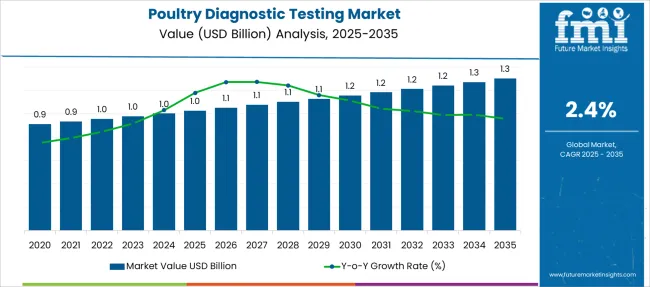
| Metric | Value |
|---|---|
| Poultry Diagnostic Testing Market Estimated Value in (2025 E) | USD 1.0 billion |
| Poultry Diagnostic Testing Market Forecast Value in (2035 F) | USD 1.3 billion |
| Forecast CAGR (2025 to 2035) | 2.4% |
The poultry diagnostic testing market is expanding steadily due to the increasing need for effective disease control in poultry farms. The growing demand for poultry products globally has prompted tighter biosecurity measures and enhanced disease monitoring programs.
Advances in diagnostic technologies have enabled quicker and more accurate detection of diseases, allowing for timely intervention and improved flock health. Regulatory agencies and industry stakeholders have emphasized disease surveillance to prevent outbreaks that could impact production and trade.
The integration of modern testing methods into routine poultry health management has become essential for sustainable farming practices. Looking forward, innovations in point-of-care testing and multiplex assays are expected to further propel market growth. Segmental growth is anticipated to be led by the ELISA test as the preferred diagnostic method and Avian Influenza as the most critical disease focus due to its high pathogenicity and economic impact.
The market is segmented by Test and Disease and region. By Test, the market is divided into ELISA Test, PCR Test, Complement Fixation Test, Immuno-Flourescent Antibody Test (IFAT), Indirect Hemagglutination Test (IHA), Direct Agglutinition Test, and Other Diagnostic Tests. In terms of Disease, the market is classified into Avian Influenza, Avian Salmonellosis, Visceral leishmaniasis or Kala-azar, Newcastle Disease, Avian Mycoplasmosis, Avian Pasteurellosis, Infectious Bronchitis, Infectious Bursal Disease, Avian Encephalomyelitis, Avian Reovirus, and Chicken Anemia. Regionally, the market is classified into North America, Latin America, Western Europe, Eastern Europe, Balkan & Baltic Countries, Russia & Belarus, Central Asia, East Asia, South Asia & Pacific, and the Middle East & Africa.
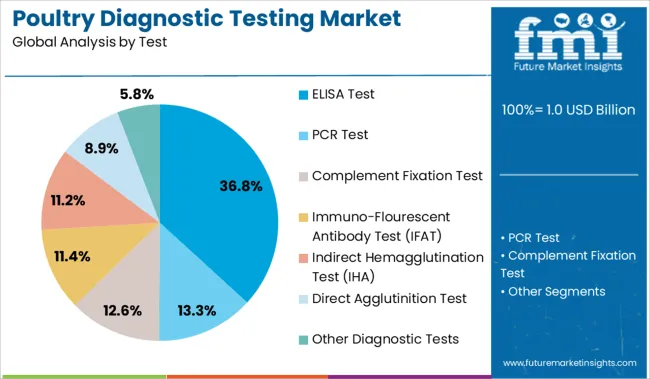
The ELISA test segment is expected to account for 36.8% of the poultry diagnostic testing market revenue in 2025, retaining its position as the leading testing method. The growth of this segment is driven by the ELISA test’s high sensitivity and specificity in detecting various poultry diseases.
Its ability to process large sample volumes rapidly has made it a preferred choice for routine screening in commercial poultry operations. The ELISA test’s compatibility with automation and ease of use have also contributed to its widespread adoption.
Additionally, this method allows for early detection, which is critical for managing disease spread within flocks. The segment benefits from ongoing improvements in assay design and reagent stability, enhancing reliability. As disease prevention remains a priority, the ELISA test segment is expected to maintain a strong market presence.
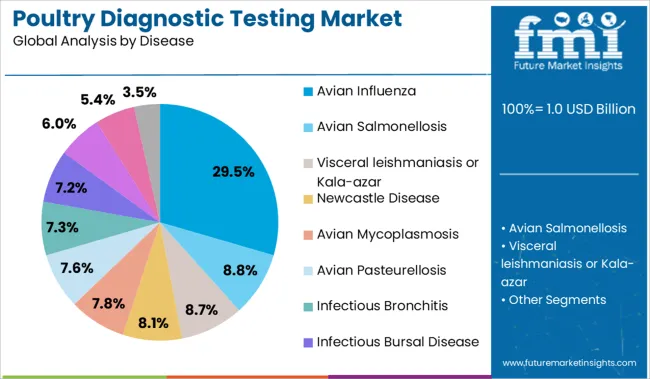
The Avian Influenza segment is projected to represent 29.5% of the poultry diagnostic testing market revenue in 2025, establishing itself as the leading disease focus. This is due to the disease’s high contagion and potential to cause severe losses in poultry populations.
The segment has grown as governments and industry players intensify surveillance and control measures to prevent outbreaks. Avian Influenza’s zoonotic potential has increased public health concerns, further driving investment in diagnostic testing.
The disease’s impact on international trade has also encouraged rigorous monitoring. Enhanced awareness and vaccination programs have increased testing frequency to detect and manage infections promptly. As the poultry industry expands globally, the Avian Influenza segment is expected to remain central to diagnostic testing efforts.
The poultry diagnostic testing market growth is expected to be propelled by the expansion of avian diseases such as bird flu outbreaks and zoonotic diseases.
The expanding reception of vaccinations, demonstrative observation of livestock birds for the nearness of infected pathogens and likely to rise the adoption of poultry diagnostic testing during the forecast period.
Improvement in the testing procedures coupled with targeted sample collections, diagnosis, clinical interpretation and enhanced laboratory quality control is likely to drive the demand for poultry diagnostic testing during 2025-2035.
Also, the rising end-user concerns food safety is anticipated to emerge as the major factor in driving the demand for poultry diagnostic testing in food exporting countries.
The rise in poultry diagnostic testing market share can be ascribed to the wide utilization of ELISA tests for preparatory screening of all avian sicknesses combined with their high affectability, specificity, and cost-effective nature.
Modern innovations are also affecting the poultry diagnostic testing market trends positively as per the market report. This factor has prompted the appropriation of different test units to distinguish the difference between various pathogens and infectious diseases, and are likely to rise the adoption of poultry diagnostics testing.
As per the latest poultry diagnostics testing market report, the absence of conclusive diagnostic testing, negative reactions, and the market's restricted adequacy of poultry pharmaceuticals may have an impact on demand for poultry diagnostic testing over the projection period.
In any case, rising production costs, a lack of poultry care awareness, and trade issues such as import bans are likely to limit poultry diagnostic testing market growth.
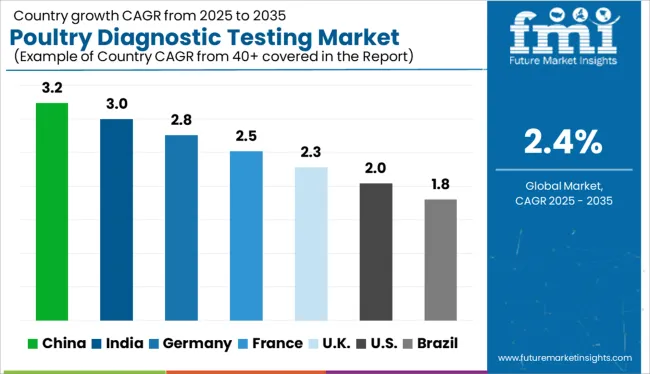
The North American region is expected to dominate the global poultry diagnostic testing market share by acquiring 35.6% of the share.
Increasing livestock populations in US and Canada, are considered vital drivers for the poultry diagnostic testing market growth. Public awareness via animal health research and development (R&D) companies, government associations and veterinary drug manufacturers, and medical campaigns are also boosting the demand for poultry diagnostic testing in the region.
The Europe region stood on second position in the poultry diagnostic testing market by acquiring 25.8% of the global share.
Rising incidences of bird flu, influenza and other viral infections among the birds (especially chicken) are boosting the sales of poultry diagnostic testing systems in the region.
Also, demand for poultry diagnostic testing is expected to rise during the projected period due to increased awareness of serological testing, target sample testing methodologies, or systematic tissue collecting procedures, as well as rising per capita animal health.
The startups in the poultry diagnostic testing market are introducing new innovative technology with the current method, to highlight the benefits of poultry diagnostic testing.
They are experimenting with various vaccines to overcome the disease spread from birds (ducks & chickens) recently, and several poultry diagnostic testing companies and scientists are working with startups to raise their methodology to innovate solid solutions related to it.
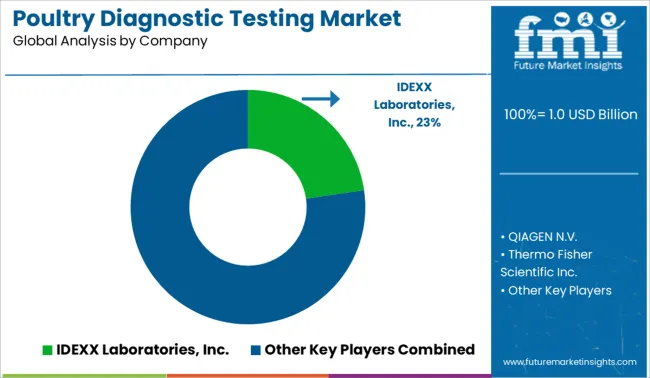
Key players in the poultry diagnostic testing market are likely to invest their precious time, efforts and strategy in improving the technology during the forecast period. They are also using various tactics including mergers, acquisitions, product launches and partnerships to expand the adoption of poultry diagnostic testing.
Some of the key players in the poultry diagnostic testing market are:
Recent Development in the Poultry Diagnostic Testing Market are:
| Report Attribute | Details |
|---|---|
| Growth Rate | CAGR of 2.4% from 2025 to 2035 |
| Base Year for Estimation | 2024 |
| Historical Data | 2020 to 2024 |
| Forecast Period | 2025 to 2035 |
| Quantitative Units | Revenue in USD Million and CAGR from 2025 to 2035 |
| Report Coverage | Revenue Forecast, Volume Forecast, Company Ranking, Competitive Landscape, Growth Factors, Trends and Pricing Analysis |
| Segments Covered | Test Type, Disease Type, Region |
| Regions Covered | North America; Latin America; Europe; East Asia; South Asia; Oceania; Middle East and Africa |
| Key Countries Profiled | USA, Canada, Brazil, Argentina, Germany, UK, France, Spain, Italy, Nordics, BENELUX, Australia & New Zealand, China, India, ASEAN, GCC, South Africa |
| Key Companies Profiled | IDEXX Laboratories, Inc.; QIAGEN N.V.; Thermo Fisher Scientific Inc.; Zoetis, Inc.; GD Animal Health; IDvet; AffiniTech, LTD.; AgroBioTek Internacional; BioNote, Inc.; BioChek; Boehringer Ingelheim; MEGACOR Diagnostik GmbH; BioinGentech Biotechnologies, Inc. |
| Customization | Available Upon Request |
The global poultry diagnostic testing market is estimated to be valued at USD 1.0 billion in 2025.
The market size for the poultry diagnostic testing market is projected to reach USD 1.3 billion by 2035.
The poultry diagnostic testing market is expected to grow at a 2.4% CAGR between 2025 and 2035.
The key product types in poultry diagnostic testing market are elisa test, pcr test, complement fixation test, immuno-flourescent antibody test (ifat), indirect hemagglutination test (iha), direct agglutinition test and other diagnostic tests.
In terms of disease, avian influenza segment to command 29.5% share in the poultry diagnostic testing market in 2025.






Full Research Suite comprises of:
Market outlook & trends analysis
Interviews & case studies
Strategic recommendations
Vendor profiles & capabilities analysis
5-year forecasts
8 regions and 60+ country-level data splits
Market segment data splits
12 months of continuous data updates
DELIVERED AS:
PDF EXCEL ONLINE
Poultry Cutting System Market Size and Share Forecast Outlook 2025 to 2035
Poultry Farming Equipment Market Size and Share Forecast Outlook 2025 to 2035
Poultry Feeder Market Size and Share Forecast Outlook 2025 to 2035
Poultry Processing Equipment Market Size and Share Forecast Outlook 2025 to 2035
Poultry Seasoning Market Size, Growth, and Forecast for 2025 to 2035
Poultry Packaging Market Insights - Trends & Future Outlook 2025 to 2035
Poultry Vitamins Market Analysis - Size, Share & Forecast 2025 to 2035
Poultry Brooder Market Trend Analysis Based on Type, Operation, Poultry, Distribution Channel, and Region 2025 to 2035
Poultry Feed Market Analysis by Livestock, Nature, Feed Type, Form, and Region from 2025 to 2035
Poultry Keeping Machinery Market Growth - Trends & Forecast 2025 to 2035
Poultry Meal Market – Growth, Demand & Nutritional Benefits
Poultry Concentrate Market
Poultry Diagnostics Market - Demand, Growth & Forecast 2025 to 2035
Meat, Poultry, and Seafood Packaging Market Size and Share Forecast Outlook 2025 to 2035
Market Share Breakdown of Meat, Poultry, and Seafood Packaging Manufacturers
Rendered Poultry Products Market Analysis by Type and Grade Through 2035
Precision Poultry Nutrition Market – Growth, Demand & Livestock Trends
Diagnostic Shipper Market Size and Share Forecast Outlook 2025 to 2035
Diagnostic Imaging Markers Market Size and Share Forecast Outlook 2025 to 2035
Diagnostic Imaging Services Market Size and Share Forecast Outlook 2025 to 2035

Thank you!
You will receive an email from our Business Development Manager. Please be sure to check your SPAM/JUNK folder too.
Chat With
MaRIA